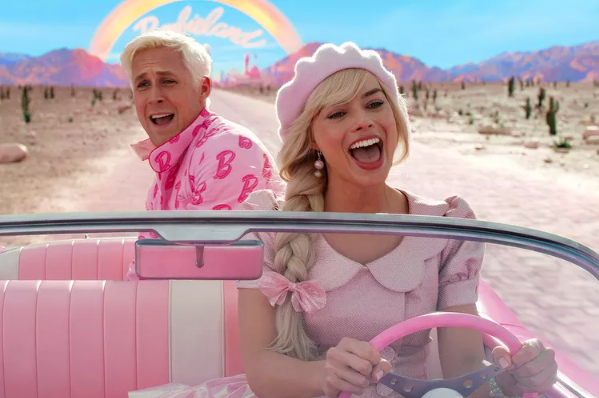
Barbie
’
s
Summer 2023 release was an initial hit, critics have pointed out flaws in plotline and character development. Photo courtesy of Warner Bros.
This summer, throngs of women flocked to theaters nationwide to watch the new Barbie movie. The movie was a total hit, sending every social media platform into a tizzy, catalyzing the iconic “girlhood” tik tok trend and a nationwide reclamation of the color pink. Arriving at my nearest AMC theater in my pink sweats, I was excited to see the movie for myself.
Set in candy-coated Barbie Land, Barbie was very pretty with gorgeous animation, but in every other respect, the movie fell flat. Its central flaw was its total lack of character development. The movie centers on a completely unmotivated conflict between a mother and her daughter and their respective conflicts with Barbie herself. The mother and daughter characters were incredibly forgettable and could have been interchanged with any other mother or daughter character. The movie made little effort to investigate their particular struggles, quirks and interests, leaving the audience with no reason investment in their specific narrative. The mother seems to be going through a generic mid-life crisis, making her decisions devoid of specific incentives and motivations. Maybe this was deliberate and she was meant to serve as a “universal” mother that all viewers could relate to, but, to me, it just reflected weak character development and lack of originality in the depiction of motherhood. Without unique, well-developed, dimensional characters, the conflicts of the movie were unmotivated, incoherent and uncompelling.
Instead of characters driving the plot, the plot imposed itself on the characters, as they served as mouthpieces for the movie’s political message. The climactic scene where America Ferrera, cast as the mother character, gives her speech about the strugles of womanhood felt incredibly heavy-handed, with little nuance or subtlety. Rather than conveying its feminist message organically through characters’ relationships, the movie plopped in a three minute cliché-filled lecture on feminism. Because of the scene’s optics, it was clear we were supposed to care, but, in reality, it was preachy, boring and most importantly, devoid of any human emotion that would make the message something to which viewers could relate.
There was nothing artful or crafty about the movie’s approach to feminism. With no nod to any of the true feminist scholars who have devoted their lives to outlining the issues of misogyny and female oppression, the movie bulldozes over all of the female scholarship that has actually aided in the feminist movement. Instead it reduced the field of feminist thought to, “smash the patriarchy!”. Moreover, depicting every male character as either a fool or villain is only counterproductive and antagonistic to progressive feminist agendas. Maybe this was an effort to depict some men’s misogynistic view of women, but, to me, it reflected the writers’ laziness and failure to investigate the complexities of gender divides and relationships.
The final scene of the movie, where Barbie watches the montage of images centered on human connection also seemed incompatible with the other themes of the movie. This scene thematizes Barbie’s yearning for human connection rather than the feminist focus that had driven the entire rest of the movie. It was out of place and failed to deliver any resolution on the movie’s central ideas. Perhaps the theme of human connection was the more worthwhile and natural topic for the movie to explore, rather than the self-conscious feminist message that awkwardly wedged itself into every scene of the movie.
I commend the movie for, at the very least, encouraging dialogue and I urge you to interrogate the movie’s message, engage with its themes and consider whether it reflects the true tenets of feminism.
















